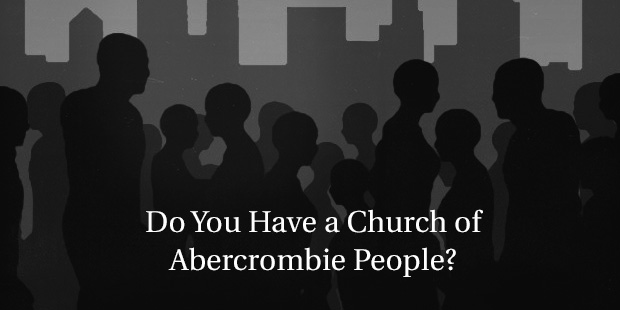
Do You Have a Church of Abercrombie People?
I’ve been watching the controversy surrounding Abercrombie and Fitch the last couple of weeks.
First, CEO Mike Jeffries made some comments which confirmed what everyone knows: that they don’t actually want most of us wearing their clothes. That backfired.
Then, Greg Karber tried to make a clever statement by giving used A&F clothes to homeless people. A lot of us (including me, I admit) thought at first glance that it was a cool idea, until we looked closer and realized it wasn’t. That backfired too.
No one appreciated Jeffries’ bold honesty about his company’s vision. So, what does a clothing store for the coolest kids in school have to say to churches? Maybe more than we might think.
Not My Style
I’ll be honest. Abercrombie and Fitch is not marketing to me.
I don’t feel comfortable entering the Abercrombie store at our local mall. I don’t feel comfortable walking past the Abercrombie store. Something about the oversized photos of half naked models in the entrance clues me in that I don’t belong there. I never was part of the crowd that they are going after, and I never will be.
But I also get the feeling that I’m not the target market of Hollister. Or Hot Topic. Or Gantos. Or Forever 21.
I think I’m part of Kohl’s target market.
Think about it. Every store has a target market, a specific niche of people who they want to buy their products. There’s nothing special about Abercrombie’s strategy. It’s just that when their CEO admits what is usually implied in such a crass and cavalier fashion, it offends our desire for inclusiveness. It’s hurtful to people like me (and I’m guessing perhaps you) who aren’t “cool” enough to be included.
Homogenized, Pasteurized Friends
Now, let’s ask a tough question, and get ready to be honest.
Who is in your target market? Like, as the CEO of your life, what niche of people are you generally spending your time with?
I’d like to think that my target market is pretty diverse and inclusive, but the results show otherwise.
I’ll go first and admit that my friend-group is pretty darn homogenous. My close friends come from generally the same socio-economic level, have about the same amount of education, and behave in a way that I find, in general, socially acceptable.
At times, I have tried to be inclusive. But there are many more times when I have not. I have taken a step back. I have withheld myself from people because they are a little too different from me in one way or another.
As embarrassing as it is to admit, I realize that my target audience is people who are sort of like me. Maybe that makes me a horrible person. If that’s the case, then maybe my target audience is horrible people.
The _________ Church
Now, let’s ask another tough question.
Who is our churches’ target audiences? Can we really say “everyone?” Why do so many of our churches looks so homogenous then? Even if your church bucks the trend and looks pretty diverse, is there someone who would have a hard time fitting in at your church?
Is it that homeless man who hasn’t had a shower or clean clothes in months? Is it the mentally ill woman? The guy with the left-field theology? The family with the special needs child? The teen mom? The alcoholic? The guy with the “alternate” lifestyle?
It’s a struggle that churches have had since the New Testament was still being written – how do we help people belong who don’t usually belong? The alternative is to admit that, on some level, we are running Abercrombie churches:
where of course everyone is equally welcome…
…but some people are more equally welcome than others.
So what do you say? How diverse is your friend-group? How diverse is your church? Who do you think is your church’s target audience?
Read more from Matt here.

Tags: Kingdom Concept, Local Predicament, Matt Appling, Vision Frame












